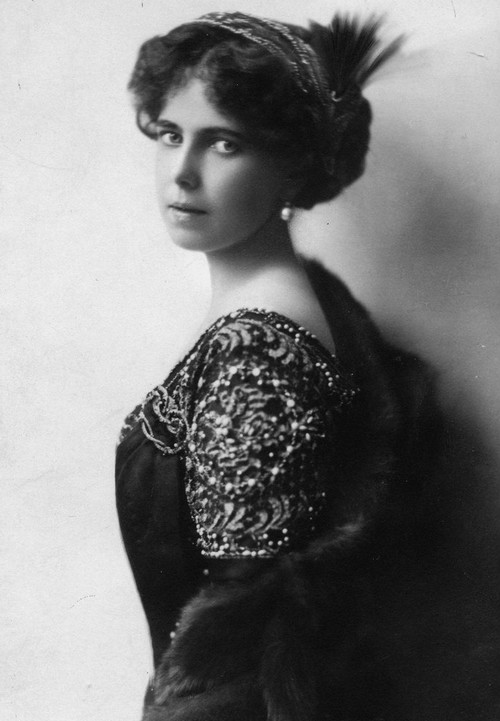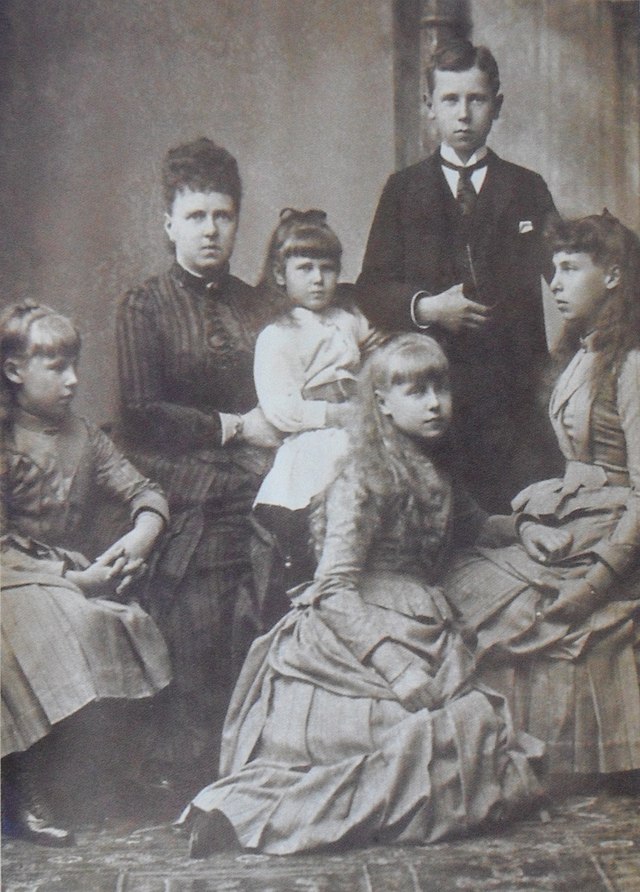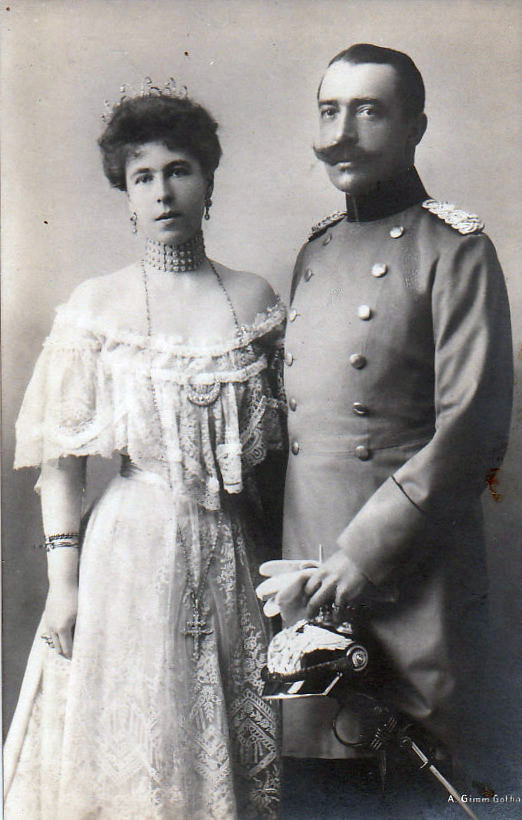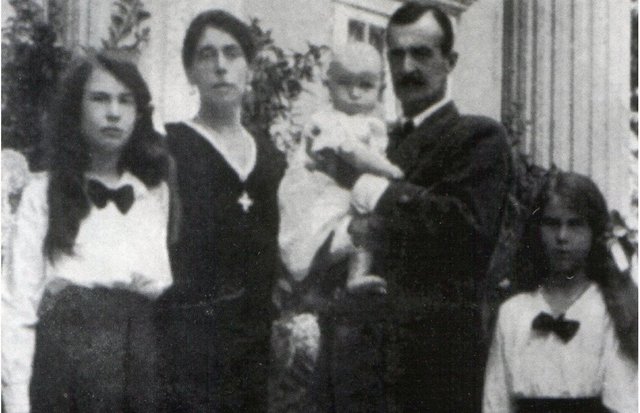by Susan Flantzer
Perhaps the two highest-profile World War I monarchs were first cousins and on opposite sides of the war. Wilhelm II, German Emperor and King George V of the United Kingdom were both grandchildren of Queen Victoria. Wilhelm was the eldest child of Queen Victoria’s eldest child Victoria, Princess Royal. George was the eldest surviving son of King Edward VII, Queen Victoria’s second child and eldest son. This month, we profile King George V and in a future month, we will profile Wilhelm, German Emperor.
King George V of the United Kingdom
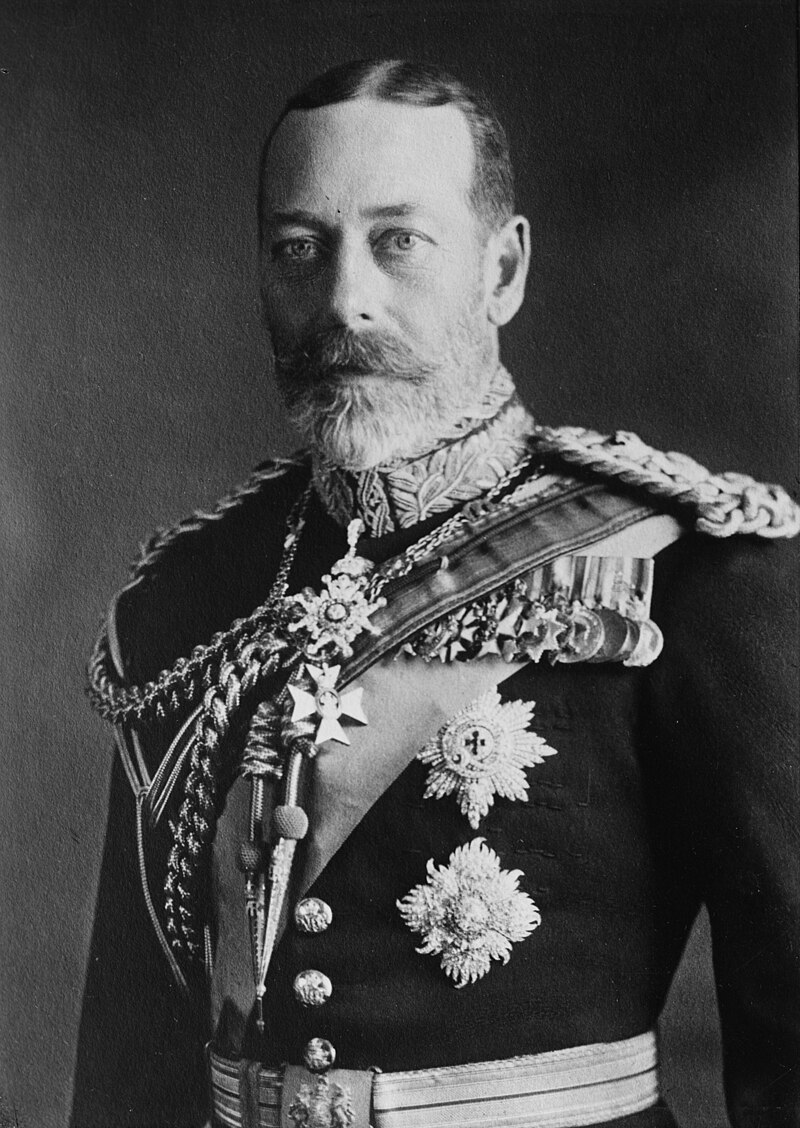
Credit – Wikipedia
King George V was born on June 3, 1865, a month early, at Marlborough House in London, England, the second son and the second of the six children of King Edward VII and his wife Alexandra of Denmark. His parents, the Prince and Princess of Wales, wanted to name him George after Prince George, Duke of Cambridge. The baby’s grandmother, Queen Victoria, thought the name George was too modern: “George only came over with the Hanoverian family.” The Prince and Princess of Wales held their ground with the name George, but had to agree to add the name Albert, so the baby’s name was George Frederick Ernest Albert. He was called Georgie in the family. At the time of his birth, George was third in the line of succession after his father and his brother Prince Albert Victor (Eddy) and he was styled Prince George of Wales. In 1892, George was created Duke of York, and when his father became king in 1901, he automatically became the Duke of Cornwall. He was created Prince of Wales on November 9, 1901.
George had five siblings:
George was only seventeen months younger than his brother Eddy. Because of the closeness in age, the two brothers were brought up and educated together. In 1877, Eddy and George joined the Royal Navy’s training ship, HMS Britannia. The brothers remained aboard the Britannia for nearly two years before embarking on a three-year cruise on the HMS Bacchante. Always accompanied by their tutor Mr. Dalton, the brothers visited the Mediterranean, the West Indies, South America, South Africa, Australia, China, and Japan.
In 1883, the brothers were separated. Eddy attended Trinity College, Cambridge University and George continued in the Royal Navy. While serving in the Royal Navy, George commanded Torpedo Boat 79 in the waters around the United Kingdom and HMS Thrush in North America. His last active service was the command of HMS Melampus in 1891–92.
George wanted to marry his first cousin Princess Marie of Edinburgh, the daughter of his uncle Prince Alfred, Duke of Edinburgh. His grandmother Queen Victoria, his father and his uncle all approved the match, but the mothers did not, and Marie was instructed to refuse when George proposed to her. On December 3, 1891, George’s brother Prince Eddy proposed to Princess Mary of Teck whose mother was a first cousin of Queen Victoria, Princess Mary Adelaide of Cambridge, the youngest child of Prince Adolphus, Duke of Cambridge (the seventh son and tenth child of King George III and Queen Charlotte). The wedding set for February 27, 1892, but on January 14, 1892, Eddy died of pneumonia.
After the death of Prince Eddy, Mary and George, now second in the line of succession, spent much time together. As time passed and their common grief eased, there was hope that a marriage might take place between them. George proposed to Mary beside a pond in the garden of his sister Louise’s home, East Sheen Lodge, on April 29, 1893. The engagement was announced on May 3, 1893, with the blessing of Queen Victoria. The couple married on July 6, 1893, and eventually became the beloved King George V and Queen Mary.
Unofficial Royalty: Wedding of George V and Princess Mary of Teck
George and Mary had six children:
On May 6, 1910, George’s father King Edward VII died and George became King. His coronation was held at Westminster Abbey on June 22, 1911. See Unofficial Royalty: Coronation of King George V and Queen Mary. In December of 1911, King George V and Queen Mary traveled to India for the Delhi Durbar where they were presented as Emperor and Empress of India.
Certainly the most difficult period of George V’s reign were years of World War I when the United Kingdom and its allies were at war with the Central Powers, led by the German Empire. Not only did about 1 million people from the United Kingdom and its colonies die, but the war pitted royal family against royal family. George was the first cousin of Kaiser Wilhelm II of Germany. He was also first cousin to both Tsar Nicholas II of Russia, who was overthrown in 1917, and his wife who was born Princess Alix of Hesse and by Rhine. At first, the British government offered asylum to Tsar Nicholas and his family, but the offer was later withdrawn. The tsar and his family remained in Russia and all were executed in 1918. In 1919, Tsar Nicholas’ mother Maria Feodorovna (George’s maternal aunt, born Dagmar of Denmark) and other members of the extended Russian Imperial Family were rescued from the Crimea by British ships.
During World War I, on July 17, 1917, King George V issued a proclamation changing the name of the British Royal Family from the German Saxe-Coburg and Gotha to the English Windsor, due to the anti-German sentiment. All George’s British relatives relinquished their German titles and styles, and adopted British-sounding surnames. The king’s compensated his male relatives by creating them British peers. All this led George’s cousin Kaiser Wilhelm to remark that he would attend a performance of Shakespeare’s “Merry Wives of Saxe-Coburg” at the earliest opportunity.
George’s relationship with his eldest son and heir Edward, Prince of Wales (known as David in the family, the future King Edward VIII) was strained. The king was disappointed in his son’s failure to settle down and appalled by his affairs with married women. However, he was fond of his second son Prince Albert (known as Bertie in the family, the future King George VI). In 1935, King George V prophetically said of his eldest son, “After I am dead, the boy will ruin himself within 12 months”, and of Prince Albert and his elder daughter Elizabeth, “I pray to God my eldest son will never marry and have children, and that nothing will come between Bertie and Lilibet and the throne.”
In his final years, King George had a number of problems exacerbated by his habit of smoking including chronic obstructive pulmonary disease and pleurisy. On January 15, 1936, King George V went to bed at Sandringham House complaining of a cold, gradually became weaker, and drifting in and out of consciousness. On January 20, when the king was close to death, his doctors issued a bulletin with words that became famous: “The King’s life is moving peacefully towards its close.” As the king lay dying of bronchitis, Bertrand Dawson, 1st Viscount Dawson of Penn, Physician-in-Ordinary to King George V, gave him a lethal injection of cocaine and morphine, thereby hastening the king’s death to ensure that the announcement of the death would appear first in the morning edition of The Times and not in some lesser publication in the afternoon.
King George’s remains lay in state in Westminster Hall in London, England where an estimated 809,000 filed past his casket. As a mark of respect to their father, the king’s four surviving sons, King Edward VIII, Prince Albert, Duke of York, Prince Henry, Duke of Gloucester, and Prince George, Duke of Kent, took the positions of the guards around the catafalque. The funeral for King George V was held at St. George’s Chapel at Windsor Castle where he was also interred.
YouTube: The Funeral Of His Majesty King George V (1936)
King Edward VIII abdicated less than a year later and his brother Prince Albert, Duke of York ascended the throne, taking the regnal name George VI. King George VI was followed on the throne by his daughter Queen Elizabeth II, the Lilibet her grandfather hoped would become queen.
*********************************************************
Timeline: June 1, 1915 – June 30, 1915
June 4: Third Battle of Krithia in Helles, Gallipoli, Ottoman Empire (now Turkey)
June 10–26: Battle of Manzikert in Malazgirt, Ottoman Empire (now Turkey)
June 21–23: Battle of Bukoba in Bukoba, German East Africa (now Tanzania)
June 22: German Field Marshal August von Mackensen breaks again through the Russian lines in the Lviv area (now in Ukraine)
June 23 – July 7: First Battle of the Isonzo near Gorizia, Italy
June 27: The Austro-Hungarians re-enter Lviv (now in Ukraine)
June 28 – July 5: The British win the Battle of Gully Ravine in Helles, Gallipoli, Ottoman Empire (now Turkey)
June–September: The Russian Great Retreat from Poland and Galicia
*********************************************************
A Note About German Titles
Many of the royals/nobles who died in action during World War I were German. The German Empire consisted of 27 constituent states, most of them ruled by royal families. Scroll down to German Empire here to see what constituent states made up the German Empire. The constituent states retained their own governments, but had limited sovereignty. Some had their own armies, but the military forces of the smaller ones were put under Prussian control. In wartime, armies of all the constituent states would be controlled by the Prussian Army and the combined forces were known as the Imperial German Army. German titles may be used in Royals Who Died In Action below. Refer to Unofficial Royalty: Glossary of German Noble and Royal Titles.
24 British peers were also killed in World War I and they will be included in the list of those who died in action. In addition, more than 100 sons of peers also lost their lives, and those that can be verified will also be included.
*********************************************************
June 1915 – Royals/Nobles/Peers Who Died In Action
The list is in chronological order and does contain some who would be considered noble instead of royal. The links in the last bullet for each person is that person’s genealogical information from Leo’s Genealogics Website or to The Peerage website. If a person has a Wikipedia page, their name will be linked to that page.
Robert Forbes-Sempill
The Honorable Maurice Hood
The Honorable Eustace Bourke
The Honorable Claude Meysey-Thompson
The Honorable Ernest Brabazon
Joachim Jobst, Freiherr von Cornberg


